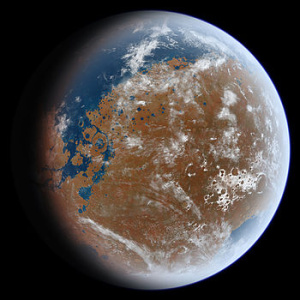Source
 British environmental guru James Lovelock, seen on March 17, 2009 in Paris, admits he was "alarmist" about climate change in the past.
British environmental guru James Lovelock, seen on March 17, 2009 in Paris, admits he was "alarmist" about climate change in the past.
By Ian Johnston, msnbc.com
James Lovelock, the maverick scientist who became a guru to the environmental movement with his “Gaia” theory of the Earth as a single organism, has admitted to being “alarmist” about climate change and says other environmental commentators, such as Al Gore, were too.
Lovelock, 92, is writing a new book in which he will say climate change is still happening, but not as quickly as he once feared.
He previously painted some of the direst visions of the effects of climate change. In 2006, in an article in the U.K.’s Independent newspaper, he wrote that “before this century is over billions of us will die and the few breeding pairs of people that survive will be in the Arctic where the climate remains tolerable.”
However, the professor admitted in a telephone interview with msnbc.com that he now thinks he had been “extrapolating too far."
The new book, due to be published next year, will be the third in a trilogy, following his earlier works,
“Revenge of Gaia: Why the Earth Is Fighting Back – and How We Can Still Save Humanity,” and “The Vanishing Face of Gaia: A Final Warning: Enjoy It While You Can.”
The new book will discuss how humanity can change the way it acts in order to help regulate the Earth’s natural systems, performing a role similar to the harmonious one played by plants when they absorb carbon dioxide and produce oxygen.
Climate's 'usual tricks'
It will also reflect his new opinion that global warming has not occurred as he had expected.
“The problem is we don’t know what the climate is doing. We thought we knew 20 years ago. That led to some alarmist books – mine included – because it looked clear-cut, but it hasn’t happened,” Lovelock said.
“The climate is doing its usual tricks. There’s nothing much really happening yet. We were supposed to be halfway toward a frying world now,” he said.
“The world has not warmed up very much since the millennium. Twelve years is a reasonable time… it (the temperature) has stayed almost constant, whereas it should have been rising -- carbon dioxide is rising, no question about that,” he added.
He pointed to Gore’s “An Inconvenient Truth” and Tim Flannery’s “The Weather Makers” as other examples of “alarmist” forecasts of the future.
In 2007, Time magazine named Lovelock as one of 13 leaders and visionaries in an article on “Heroes of the Environment,” which also included Gore, Mikhail Gorbachev and Robert Redford.
“Jim Lovelock has no university, no research institute, no students. His almost unparalleled influence in environmental science is based instead on a particular way of seeing things,” Oliver Morton, of the journal Nature wrote in Time. “Humble, stubborn, charming, visionary, proud and generous, his ideas about Gaia have started a change in the conception of biology that may serve as a vital complement to the revolution that brought us the structures of DNA and proteins and the genetic code.”
NYT: Most tie extreme weather to global warming, poll finds
Lovelock also won the U.K.’s Geological Society’s Wollaston Medal in 2006. In a posting on its website, the society said it was “rare to be able to say that the recipient has opened up a whole new field of Earth science study” – referring to the Gaia theory of the planet as single complex system.
However Lovelock, who works alone at his home in Devon, England, has fallen out with the green movement in the past, particularly after saying countries should build nuclear power stations to help reduce the greenhouse gas emissions caused by coal and oil.
'Perfect recipe' for wildfires as season starts early
Asked if he was now a climate skeptic, Lovelock told msnbc.com: “It depends what you mean by a skeptic.
I’m not a denier.”
He said human-caused carbon dioxide emissions were driving an increase in the global temperature, but added that the effect of the oceans was not well enough understood and could have a key role.
“It (the sea) could make all the difference between a hot age and an ice age,” he said.
He said he still thought that climate change was happening, but that its effects would be felt farther in the future than he previously thought.
“We will have global warming, but it’s been deferred a bit,” Lovelock said.
'I made a mistake'
As “an independent and a loner,” he said he did not mind saying “All right, I made a mistake.” He claimed a university or government scientist might fear an admission of a mistake would lead to the loss of funding.
Lovelock -- who has previously worked with NASA and discovered the presence of harmful chemicals (CFCs) in the atmosphere but not their effect on the ozone layer -- stressed that humanity should still “do our best to cut back on fossil fuel burning” and try to adapt to the coming changes.
Peter Stott, head of climate monitoring and attribution at the U.K.’s respected Met Office Hadley Centre, agreed Lovelock had been too alarmist with claims about people having to live in the Arctic by 2100.
And he also agreed with Lovelock that the rate of warming in recent years had been less than expected by the climate models.
However, Stott said this was a short-term trend that could be within the natural range of variation and it would need to continue for another 10 years or so before it could be considered evidence that something was missing from climate models.
US sees warmest March, and first quarter, on record
Stott said temperature records and other observations were “broadly speaking continuing to pan out” with what was expected.
He said there did need to be greater understanding of the effect of the oceans on the climate and added that air particles caused by pollution – which cool the Earth by reflecting the sun’s heat -- from rapidly developing countries like China could be having an effect.
On Lovelock, Stott said he had “a lot of respect” for him, saying “he’s had a lot of good ideas and interesting thoughts.”
“I like the fact he’s provocative and provokes people to think about these things,” Stott said.
Keya Chatterjee, international climate policy director of environmental campaign group WWF-US, said in a statement that it was "hard not to get overwhelmed and be defeatist" about the challenges facing the planet, but suggested alarmist talk did not help persuade people to act to reduce climate change.
"While the problem is becoming increasingly urgent, we’ve found that focusing on the most dire predictions does not resonate with the public, governments, or business. People tend to shut off when a problem does not seem solvable," she said.
"And that’s not the case with climate change because we can still avoid its worst impacts. We know that we already have all of the technologies needed to slow climate change down. We only lack the political will to go up against vested interests," she added.
States where green jobs are going gangbusters
According to the Intergovernmental Panel on Climate Change, the leading body on the subject, the world’s average temperature has risen by about 1.5 degrees Fahrenheit since 1900. By 2100, it predicts it will rise by another 2 to 11.5 degrees, depending upon the levels of greenhouse gases emitted.
Asked to give its latest position on climate change, the National Oceanic and Atmospheric Administration said in a statement that observations collected by satellites, sensors on land, in the air and seas “continue to show that the average global surface temperature is rising.”
The statement said “the impacts of a changing climate” were already being felt around the globe, with “more frequent extreme weather events of certain types (heat waves, heavy rain events); changes in precipitation patterns … longer growing seasons; shifts in the ranges of plant and animal species; sea level rise; and decreases in snow, glacier and Arctic sea ice coverage.”
NOAA reports its data in monthly U.S. and global climate reports and annual State of the Climate reports.
Its annual climate summary for 2011 said that the combined land and ocean surface temperature for the world was 0.92 degrees above the 20th century average of 57.0 degrees, making it the 35th consecutive year since 1976 that the yearly global temperature was above average.
“All 11 years of the 21st century so far (2001-2011) rank among the 13 warmest in the 132-year period of record. Only one year during the 20th century, 1998, was warmer than 2011,” it said.
In the interview, Lovelock said he would not take back a word of his seminal work “Gaia: A New Look at Life on Earth,” published in 1979.
But of “Revenge of Gaia,” published in 2006, he said he had gone too far in describing what the warming Earth would see over the next century.
“I would be a little more cautious -- but then that would have spoilt the book,” he quipped.











































































